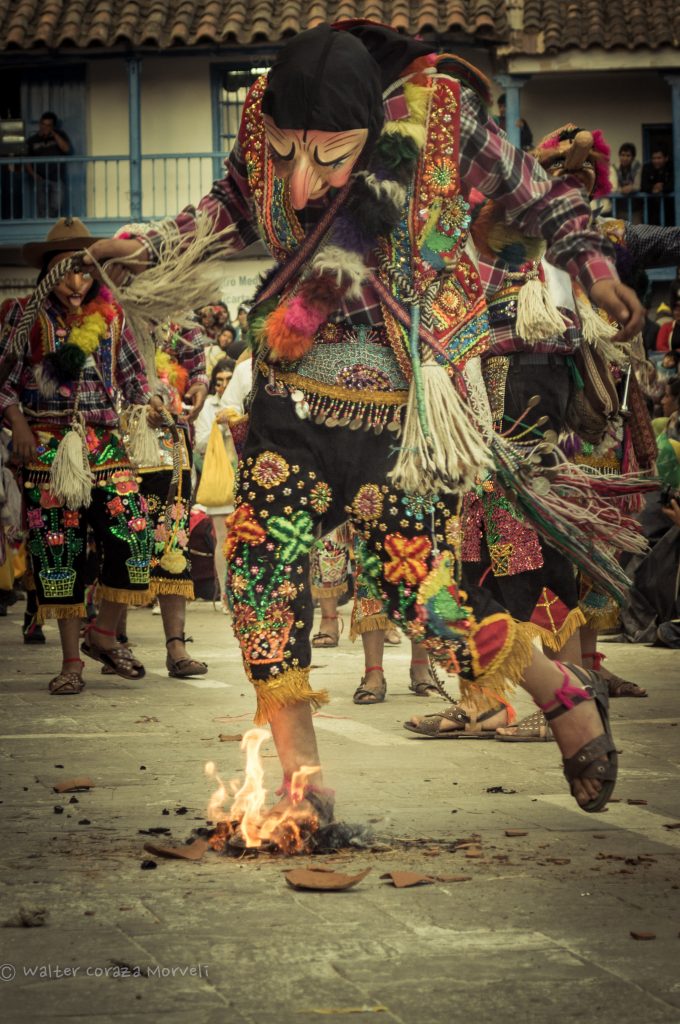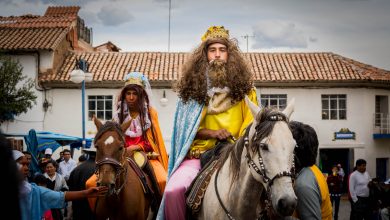Fellowships of Dancers Create Cusco

Flutes chatter and drums beat. You can’t visit Cusco without hearing this sound. The different melodies and beats–as well as different instruments, at times lead us into a key form of society that organizes the Imperial City and its region. The music has great meaning.
As the music plays, you will see a group of people gathered around the musicians, maybe in costume and maybe not. Often they are passing drinks or food among themselves. When the time is right, they take on a formation and dance. Their costumes and dance suggest bits of Cusco’s narrative or key memories.
Pulsing with energy and rhythm, they dance in the streets of the city and in its plazas. Often you will see automobile traffic slowed down or rerouted because the troupes of dancers, musicians, custodians and bearers of sacred images and banners, and assistants take the streets and process and dance.

Each of these troupes is a social group with members and it has a name. Places can be distinguished by what organizes them. Where I live in the United States, people take membership and value from being part of workplaces, churches, or various interest groups although relationship between individuals and a performance or a style is key. It is how people distinguish themselves on from another and often find friends and place.
In the town of Paucartambo, you can see the power of these essential groups in action. The town fills first with one dance troupe presenting one visual and sonoral reality in motion before the next comes in, sometimes dancing in a different direction. You see the place as a tapestry of sound, movement, and costumes in which moral theaters and history are staged.

Yet it is the people, the groups, that make the fiesta vibrant and the region of Cusco come together with an economy and passion.
When people are not on stage dancing or processing through the town, the groups gather in homes rented for the occasion or owned by a member, family, or friends where they sleep and they eat. At mealtimes, everyone gathers as dishes are served to them. While eating, they have ceremonies with speeches and humor, recognition, and organization. The doors to the house are open and anyone can enter to sit down and be fed by the group and the people who sponsor the feast with in it.

Some of the members of the groups may be from Paucartambo, but most come from Cusco or even Arequipa, Lima, and farther away, including from other countries. Belonging to the group, celebrating its name and sacred objects including devotion to the Virgen of Carmen, in this case, and other holy figures give it a focused and conscious purpose. But the group comes together and socializes even away from Paucartambo. Throughout the year they have activities making them a demanding and yet vital group people count on.
Cusco is made up of these groups, call them brotherhoods (including the sisters—I.e people in couples), comparsas, or something else. They provide the fellowship and ties that join families to society and make even the banks and government offices function as the people in these latter have ties of fellowship and celebration, as well as a common learned culture of ritual, music, and dance, that stretch throughout society, in the city, the region, and outward.
Paucartambo is an amazing event, but these fellowships become visible there. They are what make Cusco, Cusco. They give it vigor and delight.




